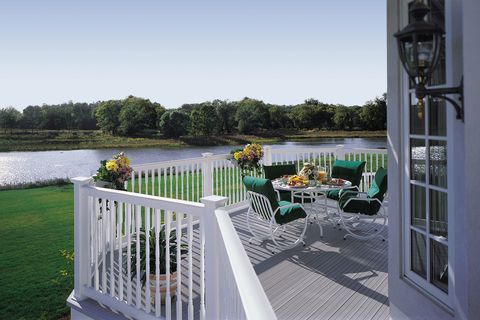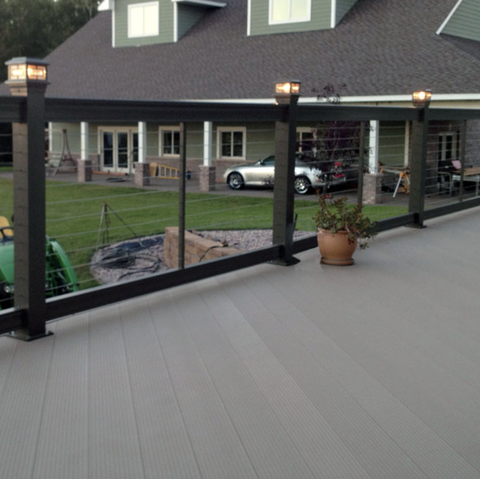Americans are focused on outdoor living like never before. In fact, according to a recent Houzz survey, more than half of respondents said they recently redid their outdoor space. The same way restaurants embraced outside dining, the pandemic left homeowners eager to expand their open-air living space, and the deck is center stage for outdoor entertaining.
“A deck is no longer a space you use for an occasional BBQ, but truly an extension of the home,” says Blythe Yost, CEO and co-founder of Tilly, an online landscape design company. “With so much emphasis on indoor/outdoor living, outdoor spaces are truly treated, designed and decorated the same as indoor spaces.” And perfect deck design starts, naturally, with the decking material.
The Good Housekeeping Institute has tested decking materials for decades, back when most decks were made of pressure-treated pine. We look at how well materials resist stains, scratches, fading and more, plus our style experts weigh in on appearance of the products. These days, there are many options to choose from, including better wood species and low-maintenance synthetics. Our decking buying guide will help you find the best decking materials according to our Lab experts as well as the nuts and bolts of pricing, design trends and installation tips. While you’re at it, up your sanctuary with our best-tested outdoor projectors, outdoor decor, small patio decorating ideas and more!
Solid Wood
Solid wood delivers the most warmth and authenticity in decking. The tradeoff for the natural beauty of any solid wood decking is the regular upkeep required.
- Pros: The advantages differ from species to species. Cedar and redwood are naturally rot-resistant species with attractive coloring and grain patterns. Tropical hardwoods like ipe and mahogany combine beauty and durability. Pressure-treated pine is the low-cost favorite, and its softness makes it relatively easy to work with.
- Cons: All wood needs to be refinished every year or so, or it will change color and crack, raising the risk of splinters. Even with diligent maintenance, the lifespan of a wood deck usually maxes out around 15 years. Wood decking is also on the expensive side, especially if you opt for cedar, redwood or one of the tropical hardwoods. As for pressure-treated pine, many consumers aren’t crazy about the chemicals used to make it resistant to rot from moisture and insects (even if arsenic is no longer used in the process after it was banned by the U.S. Environmental Protection Agency in 2004).
- Cost: Pressure-treated pine, $2 to $5 per square foot; Cedar, $3 to $7 per square foot; Redwood, $5 to $30 per square foot; Ipe, $10 to $30 per square foot.
Plastic
Also referred to as vinyl decking, this synthetic option made from PVC or polyethylene is not as common as composite, but it’s worth a look if you’re on a tight budget, with some options starting under $5 per square foot.
- Pros: Besides its low cost, plastic decking does a decent job resisting the weather and it doesn’t need to be stained. The material is also lightweight and relatively easy to cut, so it installs more easily than other decking materials.
- Cons: The biggest negative to plastic decking is that no one would ever mistake it for real wood (as they might with a high-quality composite). The material can also be a little slippery and because it’s flexible, sagging can be an issue.
- Cost: $5 to $13 per square foot
Composite
The earliest versions weren’t great looking as they were prone to fading and damage, but the technology is so much better and less maintenance. Today’s best composite decking looks like real wood, with convincing grain patterns and color-blended boards that offer a naturalistic variation. “Composite decking is definitely rising in popularity,” Yost says. “Manufacturers have really nailed the stains making them look natural.”
- Pros: Made from plastic and wood fibers, composite decking doesn’t need to be stained or treated. Today’s top formulations come with some or all sides encased in plastic to prevent mildew growth.
- Cons: While composite can be very beautiful, our experts generally find it’s the premium lines that look the best, and they can end up being even more expensive than wood. Composite decking is also quite heavy, which makes installation more difficult, maybe prohibitively so for the average DIYer.
- Cost: $15 to $36 per square foot
Aluminum
Though aluminum is another less common decking material, its popularity is on the rise, especially with the uptick in wildfires and other home damages related to extreme weather.
- Pros: It’s super durable. Though it might dent if you drop a heavy object on it, aluminum makes for an incredibly firm, rigid deck with little bounce or flexibility. The baked-on finishes that are common in the category tend to hold up well. It’s also fire-resistant, a nice attribute if you live in a wildfire area, plus it shrugs off termites and other wood-ravaging insects. Finally, aluminum decking requires very little maintenance beyond a periodic hosing down with a garden hose or pressure washer.
- Cons: The biggest negative to consider is appearance since synthetic aluminum looks nothing like wood. It’s also on the expensive side.
- Cost: $15 to $20 per square foot
Masonry
If your project calls for a patio or another on-grade structure, decking boards aren’t the best option, since they’re not meant to come in direct contact with the ground. A better option is tiles or pavers made of concrete, porcelain or other masonry material.
- Pros: This material gives you an extremely stable surface, often with clean, geometric lines that are particularly well suited to contemporary homes, though the option can work with any style of architecture.
- Cons: The biggest downside with masonry materials is the difficulty of installation. The material tends to be heavy, so a crew with serious equipment is needed to haul it around. Site preparation is critical as well to create a firm, level base for the tiles or pavers. The outdoor flooring material also tends to be on the expensive side.
- Cost: $10 to $20 per square foot
How we chose the best decking
Our experts constantly cover the marketplace to identify the decking materials you’re most likely to find at home centers, lumber yards and specialty dealers. We also regularly attend trade shows and industry events, including the International Builders Show, to keep up with all the latest trends and innovations in outdoor living. When it comes to hands-on testing, we focus on brands with a proven track record for performance and reliability. In our Labs, we run stain tests to determine how well a material resists mustard, wine, mud and more. We also run abrasion tests to see how materials withstand scratches and dings. Finally, whenever possible, we use the decking materials for actual installations at consumer testers’ homes to see how they perform under real-world conditions.
What to consider when building a new deck
✔️ Cost: While the national average cost to build a deck is around $8,000, according to HomeAdvisor, a home services marketplace, costs vary depending on the size and scope of the project, as well as the choice of material. Given inflation and ongoing supply chain issues throughout the building industry, it’s even harder to estimate the price of materials. Because periods of high volatility tend to produce wide price variation, it’s a good idea to shop around for multiple prices on decking and quotes from installers. We estimated pricing by material based on an analysis of data from sites like ANGI, HomeAdvisor and Thumbtack.
✔️ Durability: Aluminum’s attributes make it the longest-lasting decking material. But it doesn’t look like wood. If your heart’s set on a natural wood deck, look for a material that scores well on the Janka Scale, used by the industry to measure hardness. With a Janka score of 3,680, ipe is an extremely dense tropical hardwood that will fare well against scratches from pets, kids and the like. Western red cedar, by comparison, has a Janka score of 350, so it will wear easily. And if you want a more traditional look, premium composite decking offers the best combination of aesthetics and durability.
✔️ Care: Whatever decking material you choose, proper care will extend its life. Even low-maintenance aluminum, composite and plastic benefit from a thorough cleaning a few times a year. Wood decks must be refinished to prevent fading and cracking. Solid stains offer the most protection and might only need to be reapplied every few years.
Why trust Good Housekeeping?
The Good Housekeeping Institute Home Improvement Lab provides expert reviews and advice on all things home-related, including garden hoses, power saws and more. As the director of the Home Improvement & Outdoor Lab, Dan DiClerico brings more than 20 years of experience to the Institute, reviewing thousands of products (including decking and deck stains) for Good Housekeeping and previously for This Old House and Consumer Reports. He has also helped install many decks over the years — most recently, the ipe-topped terrace at his home in Brooklyn, NY.
Dan worked closely with the Institute’s Chief Technologist & Director of Engineering Rachel Rothman who oversaw the testing protocol for decking. For more than 15 years, Rachel has put her training in mechanical engineering and applied mathematics to work by researching, testing and writing about products across the home improvement space. Like Dan, she has plenty of real-world experience, both with her own projects and those she advises on at the homes of consumer testers.
This content is created and maintained by a third party, and imported onto this page to help users provide their email addresses. You may be able to find more information about this and similar content at piano.io





